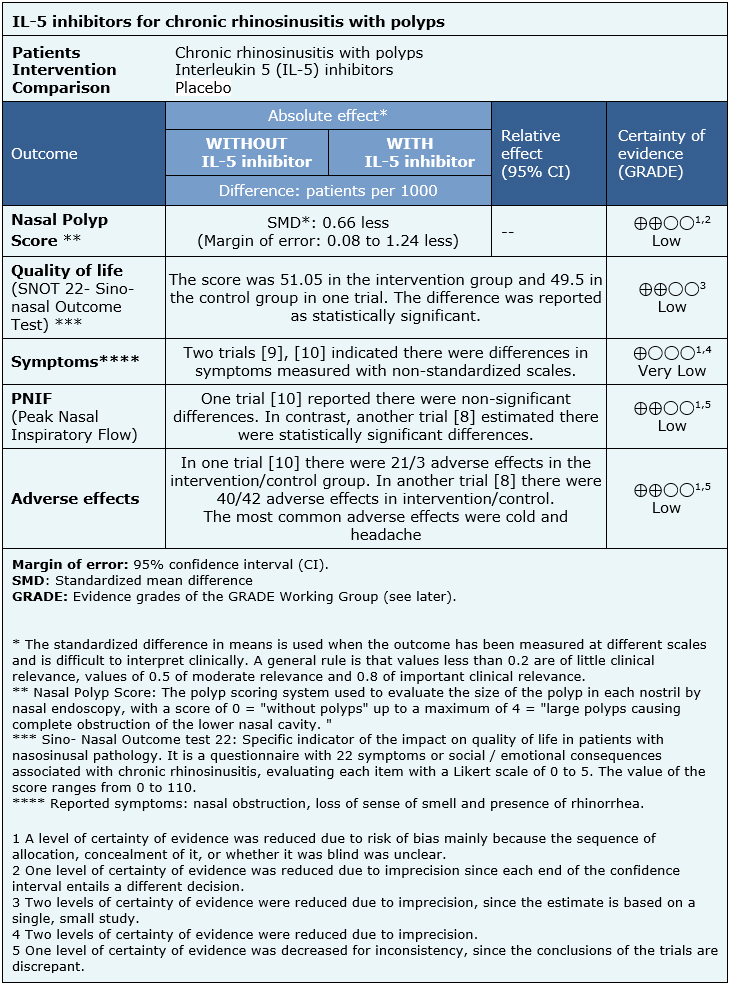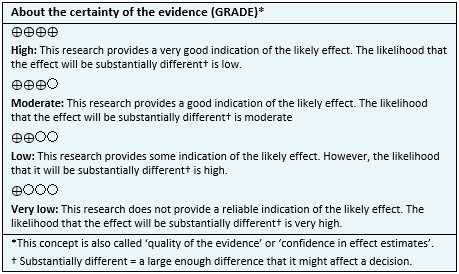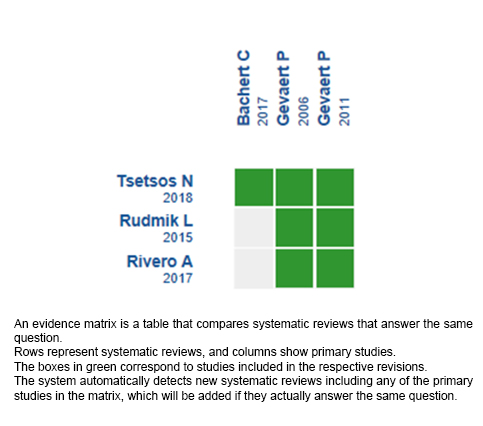 Para Descargar PDF debe Abrir sesión.
Para Descargar PDF debe Abrir sesión.
Palabras clave: Interleukin 5, chronic rhinosinusitis, nasal polyps, Epistemonikos, GRADE.
INTRODUCTION
Chronic rhinosinusitis is the inflammation of sinonasal mucosa lasting longer than 12 weeks. Two clinical forms are distinguished: chronic rhinosinusitis with polyps and without polyps. Patients with chronic rhinosinusitis with polyps exhibit high levels of interleukin 5, which promotes differentiation and survival of eosinophils. So, minimizing their circulation has been proposed as a new treatment strategy. However, there is no clarity regarding its real effectiveness.
METHODS
To answer this question we used Epistemonikos, the largest database of systematic reviews in health, which is maintained by screening multiple information sources, including MEDLINE, EMBASE, Cochrane, among others. We extracted data from the systematic reviews, reanalyzed data of primary studies, conducted a meta-analysis and generated a summary of findings table using the GRADE approach.
RESULTS AND CONCLUSIONS
We identified three systematic reviews included three primary studies overall, all corresponding to randomized trials. We concluded inhibitors of interleukin 5 might decrease nasal polyps score. Although they might be associated with adverse effects, these would be infrequent and of low severity. However, the certainty of the evidence is low.
Chronic rhinosinusitis is a chronic inflammatory disease of the sinonasal mucosa lasting longer than 12 weeks. It is estimated that 11.9% and 10.9% of the general population of the United States and Europe, respectively, have chronic rhinosinusitis [1],[2] whose symptoms significantly reduce physical and psychological well-being, affecting quality of life.
Medical treatment traditionally includes nasal washes and topical corticosteroids as maintenance therapy; systemic corticosteroids and antibiotics for exacerbations, and functional endoscopic surgery of paranasal cavities when medical and pharmacological treatment is not effective. However, there are many patients who do not respond or respond partially to treatment. One potential explanation is it focus on the relief of symptoms and reduction of inflammation rather than the cause of the disease.Interleukin 5 is a key mediator of chemotaxis, differentiation, activation and survival of the eosinophils [3]. Inhibiting this pathway would stop the release of toxic products that lead to more and lasting inflammation and formation of polyps in patients with chronic rhinosinusitis [4]. However, it is unclear what are the clinical effects of biological drugs that inhibit circulating interleukin 5, such as mepolizumab or reslizumab.
To answer the question, we used Epistemonikos, the largest database of systematic reviews in health, which is maintained by screening multiple information sources, including MEDLINE, EMBASE, Cochrane, among others, to identify systematic reviews and their included primary studies. We extracted data from the identified reviews and reanalyzed data from primary studies included in those reviews. With this information, we generated a structured summary denominated FRISBEE (Friendly Summary of Body of Evidence using Epistemonikos) using a pre-established format, which includes key messages, a summary of the body of evidence (presented as an evidence matrix in Epistemonikos), meta-analysis of the total of studies when it is possible, a summary of findings table following the GRADE approach and a section of other considerations for decision-making.
|
Key messages
|
|
What is the evidence. |
We found three systematic reviews [5],[6],[7] that included three primary studies [8],[9],[10], all of which were randomized trials. |
|
What types of patients were included* |
All trials [8],[9],[10] included patients older than 18 years. Two trials [9],[10] included patients with a history of chronic rhinosinusitis and nasal polyps (grade 3 or 4) with failure to standard medical therapy or patients with recurrent nasal polyps after surgery (grade 1-4). One trial included patients with severe recurrent bilateral nasal polyposis who required surgery after failure of standard corticosteroid therapy [8]. |
|
What types of interventions were included* |
All trials used interleukin 5 inhibitors: one trial [9] used reslizumab and two trials [8],[10] mepolizumab.Reslizumab was used in doses of 3 mg/kg and 1 mg/kg in a single dose. Mepolizumab was administered in two doses of 750 mg IV separated by 28 days in one trial [10] and in six doses of 750 mg IV separated by 4 weeks in the other [8]. |
|
What types of outcomes |
The trials evaluated multiple outcomes, which were grouped by the systematic reviews as follows:
The average follow-up was 36 weeks, with a range between 25 and 48 weeks. |
* The information about primary studies is extracted from the systematic reviews identified, unless otherwise specified.
The information on the effects of interleukin 5 inhibitors is based on three randomized trials[8],[9],[10] that included 159 patients.
Two trials [9],[10] measured the Nasal Polyp Score and symptoms through questions aboutspecific symptoms, such as nasal obstruction, loss of sense of smell and presence ofrhinorrhea (54 patients). Two trials [8],[10] reported Peak nasal inspiratory flow and adverse effects (135 patients). Only one trial [8] evaluated quality of life using the SNOT-22 specific indicator (105 patients).
The summary of findings is as follows:

| Follow the link to access the interactive version of this table (Interactive Summary of Findings – iSoF) |

|
To whom this evidence does and does not apply |
|
| About the outcomes included in this summary |
|
| Balance between benefits and risks, and certainty of the evidence |
|
| Resource considerations |
|
| What would patients and their doctors think about this intervention |
|
|
Differences between this summary and other sources |
|
| Could this evidence change in the future? |
|
Using automated and collaborative means, we compiled all the relevant evidence for the question of interest and we present it as a matrix of evidence.

Follow the link to access the interactive version: Anti IL5 for chronic rhinosinusitis with polyps.
The upper portion of the matrix of evidence will display a warning of “new evidence” if new systematic reviews are published after the publication of this summary. Even though the project considers the periodical update of these summaries, users are invited to comment in Medwave or to contact the authors through email if they find new evidence and the summary should be updated earlier.
After creating an account in Epistemonikos, users will be able to save the matrixes and to receive automated notifications any time new evidence potentially relevant for the question appears.
This article is part of the Epistemonikos Evidence Synthesis project. It is elaborated with a pre-established methodology, following rigorous methodological standards and internal peer review process. Each of these articles corresponds to a summary, denominated FRISBEE (Friendly Summary of Body of Evidence using Epistemonikos), whose main objective is to synthesize the body of evidence for a specific question, with a friendly format to clinical professionals. Its main resources are based on the evidence matrix of Epistemonikos and analysis of results using GRADE methodology. Further details of the methods for developing this FRISBEE are described here (http://dx.doi.org/10.5867/medwave.2014.06.5997)
Epistemonikos foundation is a non-for-profit organization aiming to bring information closer to health decision-makers with technology. Its main development is Epistemonikos database (www.epistemonikos.org).
Potential conflicts of interest
The authors do not have relevant interests to declare.
 Esta obra de Medwave está bajo una licencia Creative Commons Atribución-NoComercial 3.0 Unported. Esta licencia permite el uso, distribución y reproducción del artículo en cualquier medio, siempre y cuando se otorgue el crédito correspondiente al autor del artículo y al medio en que se publica, en este caso, Medwave.
Esta obra de Medwave está bajo una licencia Creative Commons Atribución-NoComercial 3.0 Unported. Esta licencia permite el uso, distribución y reproducción del artículo en cualquier medio, siempre y cuando se otorgue el crédito correspondiente al autor del artículo y al medio en que se publica, en este caso, Medwave.

INTRODUCTION
Chronic rhinosinusitis is the inflammation of sinonasal mucosa lasting longer than 12 weeks. Two clinical forms are distinguished: chronic rhinosinusitis with polyps and without polyps. Patients with chronic rhinosinusitis with polyps exhibit high levels of interleukin 5, which promotes differentiation and survival of eosinophils. So, minimizing their circulation has been proposed as a new treatment strategy. However, there is no clarity regarding its real effectiveness.
METHODS
To answer this question we used Epistemonikos, the largest database of systematic reviews in health, which is maintained by screening multiple information sources, including MEDLINE, EMBASE, Cochrane, among others. We extracted data from the systematic reviews, reanalyzed data of primary studies, conducted a meta-analysis and generated a summary of findings table using the GRADE approach.
RESULTS AND CONCLUSIONS
We identified three systematic reviews included three primary studies overall, all corresponding to randomized trials. We concluded inhibitors of interleukin 5 might decrease nasal polyps score. Although they might be associated with adverse effects, these would be infrequent and of low severity. However, the certainty of the evidence is low.
 Autores:
María José Poblete[1,2], Andrés Rosenbaum[2,3], Matías Winter[2,3]
Autores:
María José Poblete[1,2], Andrés Rosenbaum[2,3], Matías Winter[2,3]

Citación: Poblete M, Rosenbaum A, Winter M. Anti-interleukin 5 therapy for chronic rhinosinusitis with polyps. Medwave 2018;18(6):e7300 doi: 10.5867/medwave.2018.06.7300
Fecha de envío: 21/9/2018
Fecha de aceptación: 10/10/2018
Fecha de publicación: 24/10/2018
Origen: Este artículo es producto del Epistemonikos Evidence Synthesis Project de la Fundación Epistemonikos, en colaboración con Medwave para su publicación.
Tipo de revisión: Con revisión por pares sin ciego por parte del equipo metodológico del Epistemonikos Evidence Synthesis Project.

Nos complace que usted tenga interés en comentar uno de nuestros artículos. Su comentario será publicado inmediatamente. No obstante, Medwave se reserva el derecho a eliminarlo posteriormente si la dirección editorial considera que su comentario es: ofensivo en algún sentido, irrelevante, trivial, contiene errores de lenguaje, contiene arengas políticas, obedece a fines comerciales, contiene datos de alguna persona en particular, o sugiere cambios en el manejo de pacientes que no hayan sido publicados previamente en alguna revista con revisión por pares.
Aún no hay comentarios en este artículo.
Para comentar debe iniciar sesión
 Medwave publica las vistas HTML y descargas PDF por artículo, junto con otras métricas de redes sociales.
Medwave publica las vistas HTML y descargas PDF por artículo, junto con otras métricas de redes sociales.
 Hirsch AG, Stewart WF, Sundaresan AS, Young AJ, Kennedy TL, Scott Greene J,
Feng W, Tan BK, Schleimer RP, Kern RC, Lidder A, Schwartz BS. Nasal and sinus
symptoms and chronic rhinosinusitis in a population-based sample. Allergy. 2017
Feb;72(2):274-281
| CrossRef | PubMed | PMC |
Hirsch AG, Stewart WF, Sundaresan AS, Young AJ, Kennedy TL, Scott Greene J,
Feng W, Tan BK, Schleimer RP, Kern RC, Lidder A, Schwartz BS. Nasal and sinus
symptoms and chronic rhinosinusitis in a population-based sample. Allergy. 2017
Feb;72(2):274-281
| CrossRef | PubMed | PMC | Hastan D, Fokkens WJ, Bachert C, Newson RB, Bislimovska J, Bockelbrink A, Bousquet PJ, Brozek G, Bruno A, Dahlén SE, Forsberg B, Gunnbjörnsdóttir M, Kasper L, Krämer U, Kowalski ML, Lange B, Lundbäck B, Salagean E, Todo-Bom A, Tomassen P, Toskala E, van Drunen CM, Bousquet J, Zuberbier T, Jarvis D, Burney P. Chronic rhinosinusitis in European underestimated disease. A GA²LEN study. Allergy.
2011 Sep;66(9):1216-23. | CrossRef | PubMed |
Hastan D, Fokkens WJ, Bachert C, Newson RB, Bislimovska J, Bockelbrink A, Bousquet PJ, Brozek G, Bruno A, Dahlén SE, Forsberg B, Gunnbjörnsdóttir M, Kasper L, Krämer U, Kowalski ML, Lange B, Lundbäck B, Salagean E, Todo-Bom A, Tomassen P, Toskala E, van Drunen CM, Bousquet J, Zuberbier T, Jarvis D, Burney P. Chronic rhinosinusitis in European underestimated disease. A GA²LEN study. Allergy.
2011 Sep;66(9):1216-23. | CrossRef | PubMed | Gevaert P, Bachert C, Holtappels G, Novo CP, Van der Heyden J, Fransen L, Depraetere S, Walter H, van Cauwenberge P, Tavernier J. Enhanced soluble interleukin-5 receptor alpha expression in nasal polyposis. Allergy. 2003. May;58(5):371-9. | PubMed |
Gevaert P, Bachert C, Holtappels G, Novo CP, Van der Heyden J, Fransen L, Depraetere S, Walter H, van Cauwenberge P, Tavernier J. Enhanced soluble interleukin-5 receptor alpha expression in nasal polyposis. Allergy. 2003. May;58(5):371-9. | PubMed | Bachert C, Gevaert P, Holtappels G, Cuvelier C, van Cauwenberge P. Nasal polyposis: from cytokines to growth. Am J Rhinol. 2000 Sep-Oct;14(5):279-90. | PubMed |
Bachert C, Gevaert P, Holtappels G, Cuvelier C, van Cauwenberge P. Nasal polyposis: from cytokines to growth. Am J Rhinol. 2000 Sep-Oct;14(5):279-90. | PubMed | Tsetsos N, Goudakos JK, Daskalakis D, Konstantinidis I, Markou K. Monoclonal antibodies for the treatment of chronic rhinosinusitis with nasal polyposis: a systematic review. Rhinology. 2018 Mar 1;56(1):11-21. | CrossRef | PubMed |
Tsetsos N, Goudakos JK, Daskalakis D, Konstantinidis I, Markou K. Monoclonal antibodies for the treatment of chronic rhinosinusitis with nasal polyposis: a systematic review. Rhinology. 2018 Mar 1;56(1):11-21. | CrossRef | PubMed | Rudmik L, Soler ZM. Medical Therapies for Adult Chronic Sinusitis: A Systematic Review. JAMA. 2015 Sep 1;314(9):926-39. | PubMed |
Rudmik L, Soler ZM. Medical Therapies for Adult Chronic Sinusitis: A Systematic Review. JAMA. 2015 Sep 1;314(9):926-39. | PubMed | Rivero A, Liang J. Anti-IgE and Anti-IL5 Biologic Therapy in the Treatment of Nasal Polyposis: A Systematic Review and Meta-analysis. Ann Otol Rhinol Laryngol.
2017 Nov;126(11):739-747.
| CrossRef | PubMed |
Rivero A, Liang J. Anti-IgE and Anti-IL5 Biologic Therapy in the Treatment of Nasal Polyposis: A Systematic Review and Meta-analysis. Ann Otol Rhinol Laryngol.
2017 Nov;126(11):739-747.
| CrossRef | PubMed | Bachert C, Sousa AR, Lund VJ, Scadding GK, Gevaert P, Nasser S, Durham SR, Cornet ME, Kariyawasam HH, Gilbert J, Austin D, Maxwell AC, Marshall RP, Fokkens WJ. Reduced need for surgery in severe nasal polyposis with mepolizumab: Randomized trial. J Allergy Clin Immunol. 2017 Oct;140(4):1024-1031.e14.
| CrossRef | PubMed |
Bachert C, Sousa AR, Lund VJ, Scadding GK, Gevaert P, Nasser S, Durham SR, Cornet ME, Kariyawasam HH, Gilbert J, Austin D, Maxwell AC, Marshall RP, Fokkens WJ. Reduced need for surgery in severe nasal polyposis with mepolizumab: Randomized trial. J Allergy Clin Immunol. 2017 Oct;140(4):1024-1031.e14.
| CrossRef | PubMed | Gevaert P, Lang-Loidolt D, Lackner A, Stammberger H, Staudinger H, Van Zele T,
Holtappels G, Tavernier J, van Cauwenberge P, Bachert C. Nasal IL-5 levels determine the response to anti-IL-5 treatment in patients with nasal polyps. J Allergy Clin Immunol. 2006 Nov;118(5):1133-41. Epub 2006 Sep 26. | PubMed |
Gevaert P, Lang-Loidolt D, Lackner A, Stammberger H, Staudinger H, Van Zele T,
Holtappels G, Tavernier J, van Cauwenberge P, Bachert C. Nasal IL-5 levels determine the response to anti-IL-5 treatment in patients with nasal polyps. J Allergy Clin Immunol. 2006 Nov;118(5):1133-41. Epub 2006 Sep 26. | PubMed | Gevaert P, Van Bruaene N, Cattaert T, Van Steen K, Van Zele T, Acke F, De Ruyck N, Blomme K, Sousa AR, Marshall RP, Bachert C. Mepolizumab, a humanized anti-IL-5 mAb, as a treatment option for severe nasal polyposis. J Allergy Clin Immunol. 2011 Nov;128(5):989-95.e1-8. | CrossRef | PubMed |
Gevaert P, Van Bruaene N, Cattaert T, Van Steen K, Van Zele T, Acke F, De Ruyck N, Blomme K, Sousa AR, Marshall RP, Bachert C. Mepolizumab, a humanized anti-IL-5 mAb, as a treatment option for severe nasal polyposis. J Allergy Clin Immunol. 2011 Nov;128(5):989-95.e1-8. | CrossRef | PubMed | Fokkens W, Lund V, Mullol J; European Position Paper on Rhinosinusitis and Nasal Polyps group. European position paper on rhinosinusitis and nasal polyps 2007. Rhinol Suppl. 2007;20:1-136.
| PubMed |
Fokkens W, Lund V, Mullol J; European Position Paper on Rhinosinusitis and Nasal Polyps group. European position paper on rhinosinusitis and nasal polyps 2007. Rhinol Suppl. 2007;20:1-136.
| PubMed | Fokkens WJ, Lund VJ, Mullol J, Bachert C, Alobid I, Baroody F, Cohen N, Cervin A, Douglas R, Gevaert P, Georgalas C, Goossens H, Harvey R, Hellings P, Hopkins C, Jones N, Joos G, Kalogjera L, Kern B, Kowalski M, Price D, Riechelmann H, Schlosser R, Senior B, Thomas M, Toskala E, Voegels R, Wang de Y, Wormald PJ. EPOS 2012: European position paper on rhinosinusitis and nasal polyps 2012. A summary for otorhinolaryngologists. Rhinology. 2012 Mar;50(1):1-12. | CrossRef | PubMed |
Fokkens WJ, Lund VJ, Mullol J, Bachert C, Alobid I, Baroody F, Cohen N, Cervin A, Douglas R, Gevaert P, Georgalas C, Goossens H, Harvey R, Hellings P, Hopkins C, Jones N, Joos G, Kalogjera L, Kern B, Kowalski M, Price D, Riechelmann H, Schlosser R, Senior B, Thomas M, Toskala E, Voegels R, Wang de Y, Wormald PJ. EPOS 2012: European position paper on rhinosinusitis and nasal polyps 2012. A summary for otorhinolaryngologists. Rhinology. 2012 Mar;50(1):1-12. | CrossRef | PubMed |